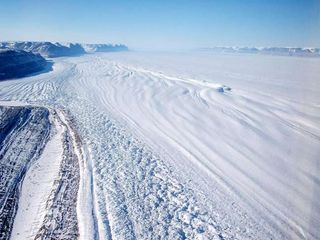Magma May Be Melting Greenland Ice

SAN FRANCISCO—Global warming may not be the only thing melting Greenland. Scientists have found at least one natural magma hotspot under the Arctic island that could be pitching in.
In recent years, Greenland’s ice has been melting more and flowing faster into the sea—a record amount of ice melted from the frozen mass this summer, according to recently released data—and Earth’s rising temperatures are suspected to be the main culprit.
But clues to a new natural contribution to the melt arose when scientists discovered a thin spot in the Earth’s crust under the northeast corner of the Greenland Ice Sheet where heat from Earth’s insides could seep through, scientists will report here this week at a meeting of the American Geophysical Union.
“The behavior of the great ice sheets is an important barometer of global climate change,” said lead scientist Ralph von Frese of Ohio State University. “However, to effectively separate and quantify human impacts on climate change, we must understand the natural impacts too.”
The corner of Greenland where the hotspot was found had no known ice streams, the rivers of ice that run through the main ice sheet and out to sea, until one was discovered in 1991. What exactly caused the stream to form was uncertain.
“Ice streams have to have some reason for being there,” von Frese said, “and it’s pretty surprising to suddenly see one in the middle of the ice sheet.”
The newly discovered hotspot, an area where Earth’s crust is thinner, allowing hot magma from Earth's mantle to come closer to the surface, is just below the ice sheet and could have caused it to form, von Frese and his team suggest.
Sign up for the Live Science daily newsletter now
Get the world’s most fascinating discoveries delivered straight to your inbox.
“Where the crust is thicker, things are cooler, and where it’s thinner, things are warmer,” von Frese explained. “And under a big place like Greenland or Antarctica, natural variations in the crust will makes some parts of the ice sheet warmer than others.”
What caused the hotspot to suddenly form is another mystery.
“It could be that there’s a volcano down there,” he said, “but we think it’s probably just the way the heat is being distributed by the rock topography at the base of the ice.”
- Top 10 Surprising Results of Global Warming
- Volcano Quiz: Part 1, Part 2
- Images: Glaciers Before and After

Andrea Thompson is an associate editor at Scientific American, where she covers sustainability, energy and the environment. Prior to that, she was a senior writer covering climate science at Climate Central and a reporter and editor at Live Science, where she primarily covered Earth science and the environment. She holds a graduate degree in science health and environmental reporting from New York University, as well as a bachelor of science and and masters of science in atmospheric chemistry from the Georgia Institute of Technology.